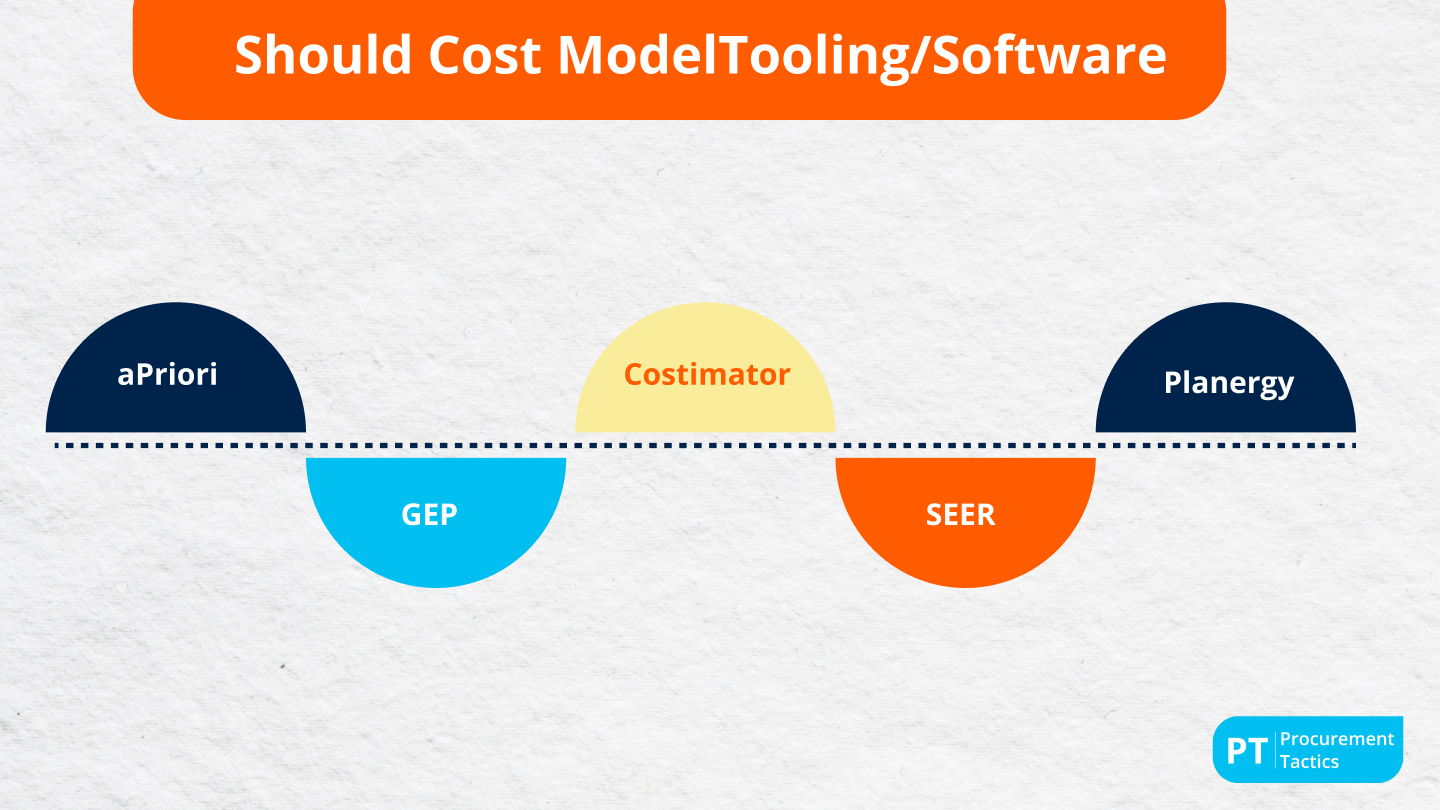ChatGPT & AI in
Procurement Course
Free Preview Lesson

Written by Marijn Overvest | Reviewed by Sjoerd Goedhart | Fact Checked by Ruud Emonds | Our editorial policy
Should-Cost Model – The Ultimate Guide
Key take-aways
- The should-cost model helps with cost breakdown, comparison, and savings negotiation by estimating the costs of goods and services.
- Essential for supply chains, it facilitates effective negotiation by comprehending and maximizing production and raw material costs.
- Scoping and data analysis are two methodical processes that contribute to the potent model development for cost comparison and reduction opportunities.
To ensure that you get the best value for your money, it is essential that you get an understanding of the costs involved in producing a product or service. This is what this article will be about.
By the end of this article, you will clearly understand should-cost modeling and how it can help you achieve cost savings for your organization. So, let’s dive in and learn how to reduce procurement costs.
What is a Should Cost Model?
A should-cost model is a tool used by businesses to determine the estimated ideal cost of a product or service. It provides a breakdown of the various cost elements involved such as the cost of materials, labor, and other factors that are used in manufacturing a good or delivering a service.
The model is also used to compare the actual cost of production to the estimated cost and to identify areas where costs can be reduced.
It is a powerful tool that helps procurement and supply chain professionals to evaluate and negotiate pricing with suppliers effectively and favorably and achieve cost savings.
Importance of Should Cost Model
A should-cost model is an essential tool for procurement and supply chain organizations. It enables organizations to effectively negotiate and collaborate with suppliers.
Understanding the drivers behind raw materials and manufacturing costs is imperative to creating cost savings opportunities for the procurement and supply chain industry.
A should-cost model helps you identify areas where you can reduce costs and negotiate better deals with your suppliers.
How to Create a Should Model for Your Own Products?
Creating a should-cost model involves a systematic approach to analyzing and evaluating the cost components of a product or service. It can be a daunting task but it is crucial to ensure that you are getting the best value for your money. Below are the steps to create a should-cost model:

1. Identify the scope
When creating a should-cost model, the first step is to determine the product or service that you want to analyze and identify the key cost drivers.
2. Gather Data
After you identify the scope of your model, the next step is to gather data. Research and collect data on material costs, labor costs, overhead costs, and profit margins. Accurate and up-to-date information is essential for a should-cost model to be effective. Thus, to achieve this consult with suppliers, market research, industry reports, or internal cost data.
3. Analyze Cost Drivers
Identify the key factors that impact each cost element. For instance, in the case of raw materials, identify factors such as market demand, availability, transportation cost, and market fluctuations as this can significantly influence the prices for each material.
4. Quantify Cost Drivers
This step requires a deep understanding of the market dynamics and supplier relationships as you will assign weights or percentages to the identified cost drivers based on their impact on the overall cost.
5. Create Your Model
The last step is to create your should-cost model by using the cost insights or data you have. This will provide you with an overall estimation of the product or service
6. Compare Estimated Cost
The last and bonus step is to compare the estimated cost to the actual cost of the product or service to identify the areas where you can reduce costs.
Should Cost Model: An Example Template
Take note! The values provided in this template are hypothetical and are solely for the purpose of illustrating what a should-cost template looks like. The numbers/figures used in this template should be customized based on actual data and analysis for a specific product/service.
The first column shows the raw materials used to make a soda. The soda includes carbonated water, sugar, caramel coloring, natural flavorings, other ingredients, and phosphoric acid. The table also includes the packaging material as a raw material as it is used as the container or base for the soda and also matters in costing the overall soda product.
The second column indicates the percentage contribution of each raw material to the total cost price of the soda. You can determine this by analyzing the cost breakdown of the product and calculating the proportion of each raw material’s cost in relation to the total cost. Ensure that the percentages for all raw materials add up to 100%.
Formula: S = (Cost of Raw Material / Total Cost of Product) * 100
The development in % vs last year column represents the percentage change in the cost of each raw material compared to the previous year. To calculate this, you need cost data for the current year and the previous year. Subtract the cost of the raw material in the previous year from the cost in the current year, divide the difference by the cost in the previous year, and multiply by 100 to get the percentage change.
Formula: D = (Current Year Cost – Previous Year Cost) / Previous Year Cost) * 100
The last column, % impact on cost price, demonstrates the percentage impact of each raw material on the overall cost price of the soda. To compute this, you need to consider the cost share of each raw material and the development in a percentage calculated in the previous steps. Multiply the % Share of Total Cost Price by the Development in % vs Last Year for each raw material to determine the % Impact on Cost Price. This will indicate the influence of each raw material on the overall cost.
Formula: I = S * D * 100
The “Total” row summarizes the entire should-cost model. In this case, the total percentage share of all the listed raw materials is 100%, which represents the entire cost structure of the soda product. The “Development in % vs Last Year” and “% Impact on Cost Price” columns in the Total row provide an overview of the overall changes in cost and their impact on the final cost price. In this example, the Total row shows a 0.954% impact, indicating a slight increase in the overall cost price compared to the previous year.
By using this should-cost model template, businesses can analyze the cost breakdown of their product, understand the contribution of each raw material, track changes in costs over time, and identify areas for cost optimization and negotiation with suppliers. It helps professionals gain insights into the cost structure and make informed decisions to achieve cost savings.
Ways to Track Raw Material Prices
Raw material costs are a significant factor in a should-cost model. To ensure that your model is accurate, you need to track the prices of raw materials especially since we are in the golden era. Here are some tips for tracking prices:
- Subscribe to industry publications and newsletters to stay up-to-date on market trends
- Use online resources such as commodity price indexes to track prices.
- Monitor the prices of raw materials from your suppliers.
- Use should-cost model software that can aggregate data from multiple sources and automate the analysis.
To keep updated with the price of raw materials you can check our price tracker.
Should Cost Model Tooling/Software
There are several should-cost model tools/software available in the market that can help you create and manage your should-cost models. These tools typically include features such as data collection, analysis, and reporting. Some of the popular software are the following:

1. aPriori
aPriori is a cloud-based should-cost modeling software that enables supply chain organizations to determine the true price of goods and services.
2. GEP
GEP is a procurement software that includes a should-cost modeling tool that helps organizations achieve cost savings.
3. Costimator
Costimator is a cost-estimating software that includes a should-cost modeling tool that enables organizations to create accurate cost estimates.
4. SEER
SEER is a project management tool from Galorath that enables you to create an accurate should-cost model that enables you to effectively negotiate with suppliers.
5. Planergy
Planergy is a procurement software that includes a should-cost modeling tool that can be used to optimize procurement.
Conclusion
In conclusion, a should-cost model is a strategic asset for organizations seeking to optimize procurement costs.
By employing a systematic approach to analyze cost components, businesses can enhance negotiation strategies, collaborate effectively with suppliers, and identify opportunities for cost savings.
The should-cost model’s significance in procurement and its potential impact on organizational efficiency cannot be overstated.
Frequentlyasked questions
What is a should-cost model?
A should-cost model is a tool used by businesses to determine the estimated ideal cost of a product or service. It provides a breakdown of the various cost elements involved such as the cost of materials, labor, and other factors that are used in manufacturing a good or delivering a service.
How important should-cost model?
A should-cost model helps you identify areas where you can reduce costs and negotiate better deals with your suppliers.
How to track the prices of raw materials for your should cost model?
Here are some ways to track the prices of raw materials, subscribe to industry publications and newsletters to stay up-to-date on market trends, use online resources such as commodity price indexes to track prices, monitor the prices of raw materials from your suppliers, and use should-cost model software that can aggregate data from multiple sources and automate the analysis.
About the author
My name is Marijn Overvest, I’m the founder of Procurement Tactics. I have a deep passion for procurement, and I’ve upskilled over 200 procurement teams from all over the world. When I’m not working, I love running and cycling.


